|
Heraldic Symbolism and Convention
My aim in putting together this section to help you to understand some of the rules and terms of heraldry. There is a lot of material to be added before this page is complete, so please be patient while I build it up as time permits.
 The precise origins of heraldry are cloudy at best. What is almost certain is that painting patterns on shields and / or armour has a military origin, born out of the need for a leader to be recognisable. It is said that the crusaders painted crosses on their shields and it is also said that the Romans did something similar. Indeed I have seen it claimed that Noah himself had a coat of arms. In Ireland there are many references to the battle standards of the first millennium Gaelic chieftains whose symbolism later appears on coats of arms. So some kind of visual symbolism, designed to identify individuals and groups existed before the emergence of formal heraldry. The precise origins of heraldry are cloudy at best. What is almost certain is that painting patterns on shields and / or armour has a military origin, born out of the need for a leader to be recognisable. It is said that the crusaders painted crosses on their shields and it is also said that the Romans did something similar. Indeed I have seen it claimed that Noah himself had a coat of arms. In Ireland there are many references to the battle standards of the first millennium Gaelic chieftains whose symbolism later appears on coats of arms. So some kind of visual symbolism, designed to identify individuals and groups existed before the emergence of formal heraldry.

It was the Normans who formalised heraldry and by the twelfth century many Norman lords had a "recognized" coat of arms. The first recorded heraldic debate broke out in 1385 when Sir Richard Le Scrope and Sir Robert Grosvenor, fought over the right to bear "Azure a bend Or". Le Scrope won, by the way. It was in the reign of Henry V of England (1413-22) that a royal proclamation is issued, prohibiting the use of heraldic ensigns except by those who could show an original a valid right. The proclamation was largely ignored. In the sixteenth century the first official Kings of Arms were set up, with authority (indeed duty) to appoint deputies to record and adjudicate on the coats of arms in use all over England and its territories. In these islands, coat of arms are now granted under the authority of the Earl Marshall, by Garter and one of the provincial Kings (of Arms) such as Clarenceux or Norroy (England and Wales), Lyon King of Arms (Scotland) and Ulster King of Arms (Ireland - now superceded by the Chief Herald of Ireland). This situation has pertained since at least the seventeenth century. Of course the rules of heraldry, not having the force of law, depend on us all behaving like gentlemen. The exception here is Scotland where heraldry has the force of law - the implication being, it seems to me, that the Scots don't know how to behave like gentlemen. I'm curious to know when the Scottish courts last heard a case of misuse of arms.
Over the centuries, the use of coats of arms became less a matter of need and more one of status. In class-conscious societies, the use of heraldic devices became linked with systems of nobility, to the point that what you could display on your arms depended on your rank within the noble pecking order (see the section on helms, below, for example). On the bottom rung of the ladder was the esquire or gentleman and at the top the king with multiple ranks in between. Below the bottom rung were the masses, regarded by the upper echelons as something less than real people. Of course, this whole system was swept away in most countries as the concept of democracy swept across the western world and many countries, including the U.S.A. and Ireland have constitutional bans on title of nobility, on the basis that "all men are equal". Even in Britain, where hereditary titles of nobility have survived and even retained powers, the reformation of the House of Lords, will result in the hereditary peers losing their vote.
Recent decades have seen a major rise in interest in coats of arms, mainly as a result of an increase in the numbers of people, especially descendants of emigrants, studying their genealogy and family history. Almost inevitably, at some point in the study of a family history, the question pops up, "is my family coat of arms?" This questions can generate two extremes of response.
The traditionalists, bound up in the conventions of an outdated class system, will respond by saying that you probably do not have a "family coat of arms" and even if you did, you would have to present volumes of pedigree information to prove that you are descended from an armiger (someone entitled to bear arms). At the other extreme, there are several merchants operating from stores, stalls, mail order outlets and the Internet, more than willing, for a modest sum, after "painstaking research", provide you with a beautiful reproduction of your "authentic" coat of arms "officially documented" or the history of your family name.
I have problems with both of these attitudes.
While it is true that in England grants of arms were made to individuals and therefore only inheritable through the senior male line, the reality is that among related families, there is usually a clear pattern of symbolism, from which, without a huge amount of difficulty, an experienced researcher can deduce a template design from which all the variant forms have been derived. And if a client has assembled sufficiently detailed genealogical information, the researcher may even by able to pin down the precise branch of the family in question. If that doesn't represent what most people today would regard as a "family coat of arms", then I don't know what would. Apart from which, the English tradition of heraldry is not the only one. In keeping with the family / sept / clan structure known to have pertained in historical Ireland, the Office of the the Chief Herald takes the view that the concept of sept arms (or family coats of arms) is perfectly acceptable. I am given to believe that similar attitudes also apply in other countries. Besides which, it is not likely that John Doe, having bought a copy of a heraldic bearing, is going to march into the House of Lords and demand his seat.
On the other hand, I find the merchants a little too free and easy. It is almost certain that if you order "the" Smith coat of arms you will be given something that is of no historical significance to you personally. Of course, this may be perfectly acceptable to you, in which case, good luck to you. But you may be sufficiently interested to know that there are thousands of unrelated Smith families, in several countries, many of whose members bore distinct coats of arms. If you are remotely interested in historical accuracy, you would do well to try to match these arms to your personal family history. On top of this, there are many family surnames whose coats of arms, if they ever had any, are unrecorded. There is not exactly a huge selection of easily accessible reference material to be had these days and most of the ancient rolls of arms have no doubt crumbled to dust in damp basements. Heraldic merchants don't go sniffing around in long abandoned castles for records. They use books, like I do, or more likely these days, they use a computer database, which I don't. Faced with an order for a coat of arms for a name that doesn't appear in the books, they move into "best fit" mode (or the computer program does). I happened to be personally interested in the name Singley and submitted a search request into one on the on-line merchants. Despite the fact that I new the name (or at least the family in which I was interested) is from continental Europe, I got back a history that insisted it is English and a description of the coat of arms that turned out to be one belonging to Synge. The only genuine coat of arms I could find in my own references for Singley was for a family in Piemont.
Which brings me to a third category of heraldists - the "traditionalist-merchant". This is a fairly new group which holds fast to the notion that arms are personal, but that the "chief" has graciously permitted the clan members to wear the badge, flower or tartan, then provides handy links where the members can pick up these lovely items at "special" prices. Let's get something straight. There are no "chiefs" - we live in democracies (most of us) and we don't need self proclaimed leaders to tell what we may or may not display. I myself am a member of a family society (The MacGeoghegan Family Society) and each five years we elect a "chieftain" in the time honoured way (we all drink pints of Guinness until only one is left standing and he gets the job). The day that chieftain tells me I can't display the Geoghegan coat of arms is the day I'll quit the society.
So, where do I fit into all this? Well, if you have read all of the above, I hope you will see me as someone who respects the art / science of heraldry but views it with a 21st century eye. I try to structure my services to allow the customer to make an informed choice before deciding to display a particular coat of arms. So, in the first instance, you can order a preliminary search, which will give you basic information on the number of coats of arms (if any) exists for a particular name. If you then wish for more detailed search on all or a subset of these, you can proceed to that step. And if you don't like or want any of the arms on record, you can always commission a new one for yourself. I don't want to give the impression that I am the only one providing an "educated merchant" service - there are several of us around as well as a number of "amateur heralds". In general we are all individuals or small groups, passionately interested in the subject of heraldry and coats of arms, but not bogged down in centuries-old, outdated convention or prepared to sacrifice accuracy in order to make a sale.
It may happen that someone will read the above and feel compelled to write to me in an attempt to debate these issues. I ask you now to save your energy. I have visited all the traditional heraldry websites and read all the material there. Similarly I have been to many of the merchant sites and, to any of them that offer the service, have submitted my standard list of surnames, invariably with the same inaccurate results (my useful list of test names remains a secret). I have neither the desire not the time to enter into a debate with any party on this subject. My views are expressed above and are not likely to change.
|
Achievement
of
Arms |
What is a coat of arms? Let me start at the beginning (a very good place to start, as Julie Andrews once said). You may have read this information on the very first page. Coats of arms are complicated things. The complete design ensemble is called an achievement of arms and consists of several parts.
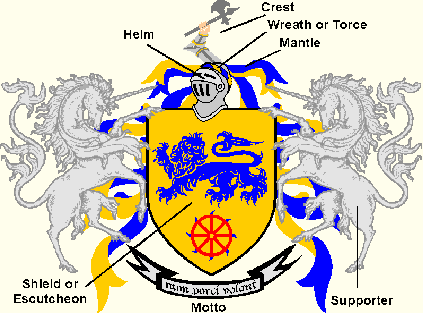 |
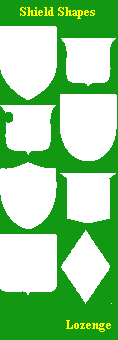

|
The escutcheon or shield is the most important and displays the primary heraldic symbolism of the arms. Indeed, the escutcheon may be the only component of many coats of arms. The shape of the shield is not defined exactly and provided that it generally resembles a shield in appearance, just about any shape is acceptable. In English heraldry women bear arms, not on a shield, but on a lozenge. Positions on the shield have their own descriptors. Right and left are referred to as "dexter" and "sinister" and always relate to the shield as if you were standing behind it. In other words the dexter side is the right side as you stand behind or the left as you look at the shield. The top of the shield is called the "chief", the middle the "fess point" and the bottom the "base". Combining these gives you terms like "dexter chief", sinister base", and so on. Shields are often divided into quarters referred to as 1st (dexter chief), 2nd (sinister chief), 3rd (dexter base) and 4th (sinister base). In any blazon (heraldic description), the first descriptor always refers to the colour or division of the shield, so a coat of arms that is simply described as "sable" consists of a simple black shield with no adornment. We will look at colours, divisions and symbols later.
The helm was added to arms before the beginning of the 14th century and in the 16th century, its form and position were modified in English heraldry to indicate the rank of the bearer. Generally, nowadays, the helm represents mere decoration.
There are four kinds of helm in English heraldry, though others are also used in heraldic practice in other countries, according to style.
1) Kings and Princes of royal blood. The helm is full faced, composed of gold, with the beauvoit divided by six projecting bars and lined with crimson.
2) Nobility. Made of steel, with five gold bars covering the face. It is shown inclining to profile.
3) Knights and Baronets. Full faced steel helmet with the visor open and no bars.
4) Esquires and Gentlemen (basically all others). A helmet of steel with the visor closed. It is always shown in profile (either full profile or partial) facing to the dexter (the helm's right the viewer's left).
The style in which each of these helms is displayed varies from artist to artist, however, the key features are the colour and the attitude (full faced or in profile). |

|
The crest is the oldest of armorial bearings having its origins in ancient Greece and Rome. In heraldry it is represented attached to the top of the helmet or above the shield. Certain families have several crests. In English heraldry in is not usual for a coat of arms to include more than one crest. However, a person with two surnames may display two coats of arms. In some continental European countries multiple crest are often displayed. The crest was often shown on cutlery, dishes, etc. which was often passed on from one generation to the next. This probably gave rise to the phrase "family crest" which has somehow come to erroneously mean the same thing as coat of arms. In a knight's full regalia, the crest would have literally been attached to the top of his helmet, so it is often a much more three dimensional object than the shield. |
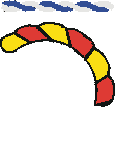

|
The wreath or torse represent twisted ribbons tinctured of the principal metal and colour of the shield and are sited above the shield (or helm if shown) and below the crest. The torse is generally coloured of principal colours (metal and colour - see below) of the shield. In some continental European coats of arms, the colour of the mantling (see below) is specified. In such cases, the torse should be coloured to match the mantling.
The motto is a phrase or sentence alluding to the family, the arms, or the crest or sometimes a traditional war cry, especially among the Celts. It is placed in a scroll above the crest or below the shield. It is not infrequently found that a coat of arms will include two mottoes, one above the crest and one below the shield. Sometimes mottoes are even incorporated into the coat of arms proper - especially the crest. Mottoes are often not recorded with a grant of arms. Mottoes are often written in Latin, French and English. In Celtic countries it is not unusual to find mottoes in the native Gaelic language. |
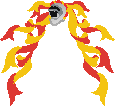
|
The mantle originally was a representation of the piece of cloth that protected the helmet from the heat of the sun. It became more decorative and was usually shown in the principal colours (usually a metal and a colour) of the shield, however in some grants of arms the colours are actually specified. There are many ways of displaying the mantling, from the simplest to the really complex and there is no set rules as to exactly how they should be drawn |
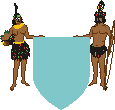
|
The supporters date from the fourteenth century and are figures, usually people or animals, placed either side of the shield. It is said that they owe their origin to the practice of knights armour bearers dressing up in all sort of fancy and grotesque regalia at tournaments. In English (and Irish) heraldry, only certain nobility and royalty are permitted supporters and so most arms do not include them. The supporters shown left are those of the civic arms of Jamaica and consist of a male and female native Indian.
Tinctures
The colours used on coats of arms are called "tinctures" and are subdivided into "metals", "colours" and "furs". |
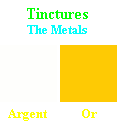

|
There are two metals which really represent the natural colours found on coats of armour. These are "argent" and "or" representing silver and gold respectively. Because of the difficulty of representing the metals properly in normal coloured drawings, white and yellow are usually used.
The colours are "sable" (black), "gules" (red), "azure" (blue), "vert" (green) and "purpure" (purple). There are also two other colours "tawney" or "tenné" (orange) and "sanguine" or "murrey" (maroon) which are only rarely encountered. There is no strict rule regarding what shade of colour should be used to portray tinctures. The only real rule is that the colour be clearly identifiable as the specified tincture. For the metals, many artist use shades or grey and darker brownish yellows to try to simulate their metallic origins and this is acceptable practice.
People often ask if these colours have any significance. The answer is most likely "no", but here are some "meanings" that have been associated with them (believe it if your wish).
Or (yellow or gold): Generosity and elevation of the mind
Argent (white or silver): Peace and sincerity
Gules (Red): Warrior or martyr; Military strength and magnanimity
Azure (Blue): Truth and loyalty
Vert (Green): Hope, joy, and loyalty in love
Sable (Black): Constancy or grief
Pupure (Purple): Royal majesty, sovereignty, and justice
Tawny or Tenne (Orange): Worthy ambition
Sanguine or Murray (Maroon): Patience in battle, and yet victorious |

|
Furs are represented by patterns of two (rarely more) colours. The most common is "ermine" which consists of a black symbol on a white background. The symbol is said to represent the tail of the ermine (a weasel-like creature). With the colours reversed it is known as "ermines", black spots on a gold background is erminois and reversed is called "pean". Other colour combinations within the ermine pattern are not unknown, but are rare and practically unheard of in English heraldry.
 "Vair", unless otherwise noted, is a pattern of argent and azure shapes supposed to resemble the flower of the campanula. When different colours are used the term "vairé" is applied followed by the names of the colours. In the red and gold example to the left left the pattern is called "vairé or and gules". There are also several variations on the vair pattern based on the configuration of the bell shapes. Two, "counter vair" and "vair in pale" are shown left. "Vair", unless otherwise noted, is a pattern of argent and azure shapes supposed to resemble the flower of the campanula. When different colours are used the term "vairé" is applied followed by the names of the colours. In the red and gold example to the left left the pattern is called "vairé or and gules". There are also several variations on the vair pattern based on the configuration of the bell shapes. Two, "counter vair" and "vair in pale" are shown left.
A less common fur is "potent" which employs shapes resembling crutch heads. "Potent" itself is rarely found in heraldry but "potent counter potent" is seen from time to time.
Those who assign meanings to heraldic symbols say that furs represent dignity.
The term "counterchanged" refers to a shield of two tinctures, a metal and a colour, the objects (or parts thereof) which lie on the metal part taking the tincture of the colour and vice-versa.
There are other patterns that are based on object. For example a cross-hatched pattern is called "crusily" i.e. of crosses, a diamond shaped patter is called "fretty", a background covered with teardrop shapes is called "guttée" (for example "guttée du sang" mean covered in drops of blood and the term "semée" just means covered with, for example, "semée de lis" mean covered with fleurs-de-lis. Other patterns include lozengy (alternately coloured diamond shapes), chequy (alternately coloured squares) and so on and so forth.
There is one final colour descriptor that is commonly found and that is "proper". This signifies that the symbol should be shown in its natural colour and is usually used in reference to animals, weapons, tools, etc. What is "proper" for particular symbols often varies greatly from artist to artist.
Before we leave the subject, there is a "rule" of heraldry relating to tinctures that I should mention. This says that you must never place metal on metal, colour on colour or fur on fur. In other words, if your shield is "argent" or "or", then the symbols directly on the shield should consist of a colour or fur and not a metal. The rule continues down the levels so that the symbols, if "charged" with yet another symbol, must comply with the same rule. Now this rule is often violated and there are some famous instances of it being broken. But if designing a new coat of arms with a view to registering it with a heraldic authority, I would suggest that you follow the "rule of tincture" for the easiest passage through the registration process. |
|
Dividing the shield - "partitioning" |

|
In many coats of arms the shield is plain, but in many more it is divided into segments and this is called "partitioning". See the examples on the left. The lines of partition are not necessarily straight or "right", as in the examples. The following lines of partition are often found.
Engrailed Invected Invected
Wavy Embattled/Crenellée Embattled/Crenellée
Nebulée Indented Indented
Dancettée Raguly Raguly
Dove tailed Potenteé Potenteé
So, by partitioning the shield using the various lines of partition, hundreds of variations of design become available. Just two example are shown left, "per fess indented or and purpure" and "per pale wavy gules and argent". When describing such partitioned shield, in the case of those partitioned horizontally the tincture of the topmost part is listed first, while the dexter is described first in the case of a vertical partition. For a quartered shield the segments are described as 1st (dexter chief), 2nd (sinister chief), 3rd (dexter base) and 4th (sinister base).
As anyone who has seen a few coats of arms will know, shields rarely consist of just partitions. In fact the majority of coats of arms also include symbols or "charges" that are added to increase even more the range of designs available. The simplest of these symbols consist of fairly simple geometric shapes and these are known as ordinaries and sub-ordinaries. Some of the names will already be familiar from the partitioning section above. |

|
The "chief" is a horizontal band that occupies approximately the top one third of the shield area, although artists will often break the one third rule depending on the shield layout.
The "pale" is a vertical band in the centre of the shield. Its origin is said to lie in a piece of wood carried by soldiers to encamp them.
The "bend" is a diagonal band from dexter chief to sinister base and is said to represent a shoulder scarf or baldric. A "bend sinister" is the same as a bend but stretch from sinister chief to dexter base. It is often said to be an indication of illegitimacy and while this is sometimes true it is not a hard and fast rule.
The "fess" or "fesse" is a horizontal band occupying the centre of the shield. Its origin is in the military girdle and it often represents public or military service. The "bar" is a diminutive of the fess, about half as deep (top to bottom).
 The "cross" and "saltire" (or St. Andrew's Cross) need no explanation. The "cross" and "saltire" (or St. Andrew's Cross) need no explanation.
The "chevron" an inverted V-shaped charge is sometimes said to be derived from the bow shaped war saddle. It is also said to be related to a bridge. The "chevronell" is a diminutive of the chevron being only about half as deep (top to bottom).
When other charges are positioned in the shape of an ordinary, they are said to be "in chief", "in pale", "in bend", etc. So, "three lions in pale" means that the lions are positioned one above the other in a perpendicular manner. Similarly, "five stars in saltire" means one in the centre and the other four in the corners. Sometimes terms like "fessways", "bendwise", etc. are also used to denote the configuration.
The sub-ordinaries include the "border" or "bordure", the "orle" and the "inescutceon" all of which take the general shape of the shield. The border in particular is often used to distinguish different branches within a family.
The "quarter" occupies one fourth of the shield, touching two edges. The "canton" is smaller than the quarter and is usually place in the dexter chief. Cantons were frequently added to shields by royal order as a recognition of some great deed.
A "billet" is a n oblong rectangular shape. When there are more than ten and they are irregularly placed on the shield, they form a pattern known as "billettée".
A "pile", said to represent the base of a bridge, is a large inverted solid v-shaped charge. It is usually position with the base at the top of the shield pointing downward.
The "paille" or "pall" is y-shaped. Such a charge when it doesn't touch the edges of the shield is known as a shakefork, made famous on the arms of Cunningham.
The "flaunch" usually found in pairs and at the sides of the shield, is a (approximately) a quarter segment of a circle.
A "lozenge" is diamond shaped and when hollow or pierced is known as a "mascle".
A "fret" is a complex-looking knot. In fact it is a narrow saltire intersecting a mascle. I have heard it referred to as the "Harrington knot", the charge being found on the coat of arms of Harrington.
A "goutte" is a drop- or tear-shaped charge. It is named according to its tincture. Or - gouté d'or, argent - gouté d'eau (drop of water), gules - gouté de sang (drop of blood), azure - gouté de larmes (teardrop), vert - gouté de vert and sable - gouté de poix (drop of pitch).
A "roundle" is a simple solid circle and when hollow or pierced is called an "annulet". Roundles of different tinctures have specific names. Or - "bezant" (representing a gold coin), argent - "plate", gules - "torteau", vert - "pomey", azure - "hurt", sable - "ogress" or "pellet", purpure - "golpe", tawney - "orange" and sanguine "guze". |
Common
Charges |
All charges that are not ordinaries or sub-ordinaries are known as common charges and a huge variety of them have been employed over the centuries, some well-known and other rare and curious. All sorts of things have been represented including, animals, fish, birds, reptiles, monsters, plants, tools, shapes, musical instruments, buildings, weapons, instruments of torture, and so on and so forth. It would be an impossible task to show and discuss them all here so I will just mention some popular ones and talk about some general principles. |
Animals |
The lion is perhaps the most commonly used heraldic beast of all. It has been portrayed in many different ways. It's "attitude" is described as "rampant" (upright attacking), "passant" (walking), "statant" (standing), "sejant" (sitting), "couchant" (lying), "dormant" (sleeping) and several other less common postures. The position of the head is looking as if looking straight ahead unless otherwise described as in, for example, "guardant" (looking out from the shield) and "reguardant" (looking behind). |
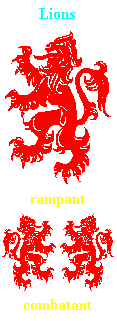
|
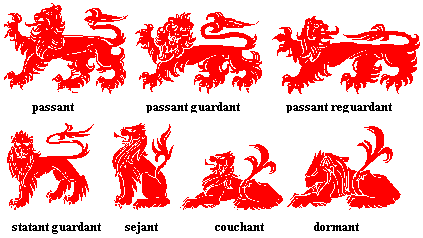
Two lions rampant in a posture of fighting each other are referred to as "combatant" and in general any pair of animals facing each other are said to be "respectant" of "respecting each other".
|

|
A griffin in the rampant position with its wing open, is said to be "segreant" |
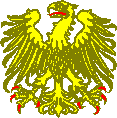
|
An eagle full frontal with its wings spread open is said to be "displayed" 
A head, or any other body part, whose bottom margin is shown straight (as if it had been sliced off) is termed "couped". A part that is jagged (as if it had been ripped off) is termed "erased" |
Before any artist can properly represent a coat of arms he or she must understand the written heraldic language - the "blazon". It is not, nor was it ever, convenient to store vast archives of pictures of coats of arms, so heralds devised a written method of describing coats of arms. The language is a strange looking mixture of English and French and like most languages has its own vocabulary, grammar and syntax. Even so, it is not as precise as it might be and six different heraldic artists may offer as many graphic interpretations of the same blazon. However, all six should still be identifiable as the same coat of arms. Tradition plays a large part in how arms are drawn, for example one family may have a time honoured way of displaying an eagle on their arms that is quite different to how another family displays the same charge, while the blazons for both describes it in the exact same way.
Blazons are supposedly devoid of punctuation, yet many armorials (books that contain blazons) use punctuation. Repetition is studiously avoided. For example, if two charges have the same colour the second is described as "of the first", "of the second", etc. depending on where in the blazon the colour is first mention. If a charge is the same colour as the shield, it is often described as being "of the field", though "of the first" would serve the same purpose. Similarly if different charges appear on the shield win the same frequency, the number is only mentioned explicitly for the first, the other or others being described as "as many".
First to be described in any blazon is the shield itself. If it is plain, then the first word in the blazon is the tincture, so "Azure ..." immediately denotes a blue shield. If the shield is partitioned the mode of division is described first, for example "Per fess or and gules ..." means, divided horizontally, top half yellow or gold, bottom half red". In all such cases, the segments are always described in line with seniority i.e. dexter chief being the most senior, then sinister chief, dexter base and sinister base. So when a shield is divided horizontally (per fess or per chevron) the tincture of the top part is described first, when divided horizontally the dexter is described first and so on.
Next to be described is the principal ordinary, following the same general rules. The tincture of the ordinary (and this rule applies to other charges too) is stated after the name and description of it. For example "Azure a fess argent" or "Azure a fess indented argent". If the ordinary has charges thereon then it is described as "on a ... " for instance "Azure on a fess argent a mascle gules". If a shield consists of only two tinctures and the charges are not borne on each other, then the tincture name comes after the ordinary and the charge description. For example "Azure a fess between three mascles argent" indicates that the fess and the mascles are all the same colour. When a charge is the same tincture as the previous mentioned but it is not possible to write the blazon in this all inclusive manner, then the expression "of the last" is used. For example "Azure a fess argent, on a chief of the last a mascle gules". If the mascles were on the fess and the same colour as the shield, then the blazon would read "Azure on a fess argent three mascles of the field (or of the first) ...". The positioning and layout of charges should also be defined. For example, as mentioned above, "fessways" or "in fess" means in a straight horizontal line, "in pale" means in a straight vertical line, and so one. When there are several similar charges, their layout may be described in descending vertical lines, for instance "four, three, two and one". Charge positions may be described in relation to the shield, "in dexter chief", "in base", etc. Some positions need not be described. A single charge is assumed to occupy a central position and three charges are place two in chief and one in base, unless otherwise specified.
Some charges (especially animals) must have their "attitude" described. Lions, for instance, can have all sorts of attitudes including "rampant", "passant", "sejant", etc. and even within these there may be differences, "rampant guardant", "rampant, reguardant", etc. Finally charges may also have secondary tincturing. Animals may be "langued" (tongue), "armed" (claws), "tusked", "winged", "queued" (tail), etc., flowers can be "barbed", "seeded", etc. and other objects can be "garnished", all in a different tincture to the main part of the charge. For instance a "lion rampant gules armed and langued azure" means that the lion is red but its tongue and nails are blue. While we are on animals, body parts are described as "couped" if they are cut cleanly (i.e. the bottom edge is straight) and "erased" if they look as if they have been ripped off (i.e. the bottom edge is ragged). Similarly a plant that is described a "slipped" is shown with a root as if it had been pulled from the ground, while a tree that has suffered a similar fate is termed "eradicated". When a charge is surrounded by multiple other charges, it is blazoned as "within". For example "a lion rampant within an orle of fleurs-de-lis azure". |
|
|